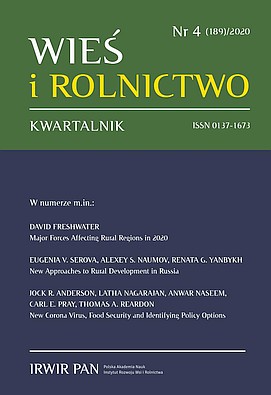Major Forces Affecting Rural Regions in 2020
DOI:
https://doi.org/10.53098/wir042020/01Keywords:
rural development, rural/urban divide, social conflict, rural policy, populismAbstract
Rural regions in OECD countries have always faced development challenges, resulting from their: reliance on natural resources, small labour forces, and long distances from markets, as well as the effects of globalization. Now, in addition, their development opportunities are further constrained by: climate change requirements, increased economic fragility resulting from COVID and the lingering effects of the 2008 recession, and the uneven impacts of the Internet economy. But, from a rural development policy perspective, perhaps the most important new challenge is the rise of rural populism. While rural areas and people have long been seen as distinct from their urban counterparts, in the last two decades these gaps have grown. Importantly, while the internet and information and communications technology (ICT) were initially seen as providing opportunities to improve social cohesion and link rural and urban people and places, instead they seem to have increased tensions. Because the core values of urban and rural people have grown so far apart, it is more difficult to establish the political compromises that are required to form effective policy. Absent some reconciliation of these social and political differences, it is difficult to see how national government policy can evolve to meet new challenges. Consequently, the likelihood of national governments being able to identify and implement coherent rural development policies is reduced.
References
Champion T. (2007). Defining “urban”: The disappearing urban-rural divide. In: Geyer H.S. (ed.), International Handbook of Urban Policy, vol. 1 (pp. 22–37). Cheltenham: Edward Elgar. DOI: https://doi.org/10.4337/9781847208651.00010
Filene P. (1970). An obituary for the “Progressive Movement”. American Quarterly, 22 (1), 20–34. DOI: https://doi.org/10.2307/2711670
Frank Th. (2004). What’s the Matter with Kansas? New York: Henry Holt and Company.
Freshwater D. (2000). Rural America at the turn of the century: One analyst’s perspective. Rural America, 15 (3), 2–7.
Freshwater D., Trapasso R. (2014). The Disconnect between Principles and Practice: Rural Policy Reviews of OECD Countries. Paris: OECD Publishing. DOI: https://doi.org/10.1111/grow.12059
Hodge I. (2003). Mainstreaming rural development policy under the CAP. Journal of Environmental Policy and Planning, 5 (3), 361–378. DOI: https://doi.org/10.1080/1523908032000171639
Holmes W. (1990). Populism: In search of context. Agricultural History, 64 (4), 26–58.
Isserman A. (2001). Competitive advantages of rural America in the next century. International Regional Science Review, 21 (1), 38–58. DOI: https://doi.org/10.1177/016001701761013006
JEC (Joint Economic Committee of Congress) (1986). The Bicoastal Economy: Regional Patterns of Economic Growth during the Reagan Administration. Washington, D.C.: Government Printing Office.
Mayhew A. (1972). A reappraisal of the causes of farm protest in the United States, 1870–1905. The Journal of Economic History, 32 (2), 464–475. DOI: https://doi.org/10.1017/S0022050700067206
Mudde C., Kaltwasser C. (2017). Populism: A Very Short Introduction. Oxford: Oxford University Press. DOI: https://doi.org/10.1093/oxfordhb/9780198803560.013.1
North D. (1966). Growth and Welfare in the American Past. Englewood Cliffs, NJ: Prentice-Hall.
Nugent W. (2009). Progressivism: A Very Short Introduction. Oxford: Oxford University Press. DOI: https://doi.org/10.1093/actrade/9780195311068.001.0001
OECD (Organisation for Economic Cooperation and Development) (2006). The New Rural Paradigm. Paris: OECD Publishing.
OECD (Organisation for Economic Cooperation and Development) (2010). Strategies to Improve Rural Service Delivery. Paris: OECD Publishing.
OECD (Organisation for Economic Cooperation and Development) (2016). OECD Regional Outlook: 2016. Paris: OECD Publishing.
OECD (Organisation for Economic Cooperation and Development) (2020). Policy Implications of Coronavirus Crisis for Rural Development. Paris: OECD Publishing. Available: http://www.oecd.org/coronavirus/policy-responses/policy-implications-of-coronavirus-crisis-for-rural-development-6b9d189a/
OTA (Office of Technology Assessment) (1991). Rural America at the Crossroads. Office of Technology Assessment. Washington, D.C.: US Government Printing Office.
Overman H., Gibbons S. (2011). The Future of Rural Policy: Lessons from Spatial Economics. SERC Policy paper 8. London: London School of Economics. Available: http://eprints.lse.ac.uk/59234/1/__lse.ac.uk_storage_LIBRARY_Secondary_libfile_shared_repository_Content_LSE%20Spatial%20Economic%20Research%20Centre_SUNAINA%20SERC_sercpp008.pdf
Parker E. (2000). Closing the digital divide in rural America. Telecommunications Policy, 24 (2), 281–290. DOI: https://doi.org/10.1016/S0308-5961(00)00018-5
Schaeffer P., Loveridge S., Weiler S. (2014). Urban and rural: Opposites no more! Economic Development Quarterly, 28 (1), 3–4. DOI: https://doi.org/10.1177/0891242413520089
Schoene M. (2019). European disintegration? Euroscepticism and Europe’s rural/urban divide. European Politics and Society, 20 (3), 348–368. DOI: https://doi.org/10.1080/23745118.2018.1542768
Ward N., Brown D. (2009). Placing the rural in regional development. Regional Studies, 43 (10), 1237–1244. DOI: https://doi.org/10.1080/00343400903234696
Weber B., Freshwater D. (2016). The death of distance? Networks, the costs of distance and urban-rural interdependence. In: Shucksmith M., Brown D. (eds.), Routledge International Handbook of Rural Studies (pp. 154–164). Routledge: New York.
Zerofsky El. (2018). The Gilets Jaunes movement. The New Yorker, December 13, 2018. Accessed June 26, 2020 at https://www.newyorker.com/news/news-desk/the-complicated-politics-of-the-gilets-jaunes-movement
Zitner A., Chinni D. (2020). How the 2020 election deepened America’s white-collar/blue-collar split. Wall Street Journal, November 24, 2020. Available: https://www.wsj.com/articles/how-the-2020-election-deepened-americas-white-collar-blue-collar-split-11606219208?mod=politics_lead_pos3
Downloads
Article file downloads
Pages
How to Cite
Issue
Section
License
Copyright (c) 2021 Wieś i Rolnictwo

This work is licensed under a Creative Commons Attribution 4.0 International License.










